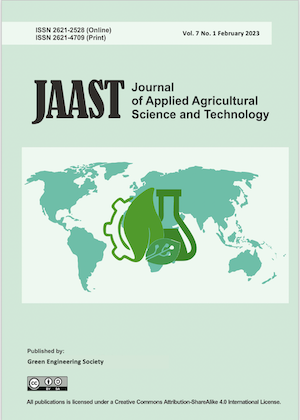Environmental-Economic Analysis of Portable Mixed-Mode Greenhouse Dryer for Fig Leaves
##plugins.themes.academic_pro.article.main##
Abstract
Energy and environomical analysis play important role in designing a solar thermal drying system as these analyses identify the high energy-consuming area, formulate energy-saving measures and evaluate the size of any potential savings. In this study, a greenhouse solar dryer with a double-pass multi-hollow collector for leaf drying was evaluated using environmental-economic analysis. Environmental analysis includes the determination of embodied energy, energy payback time (EPBT) period, as well as CO2 emissions per year, carbon mitigation and carbon credit. The embodied energy of a passive dryer is 606.86 kWh and EPBT of 16.68 years, while for an active dryer, the values are determined at 636.17 kWh and 10.39 years, respectively. CO2 emission for the passive dryer is 47.17 kg per year, net CO2 mitigation of 124.6 kg, and earned carbon credit of RM 2.58 – RM 12.38. The active dryer has CO2 emission of 47.14 kg, net CO2 mitigation of 594 kg, and earned carbon credit of RM 51.95 – RM 247.66. Economic analysis of this dryer shows that the energy cost associated with its operation ranges from RM 1.59 to RM 4.77, monthly.
##plugins.themes.academic_pro.article.details##

This work is licensed under a Creative Commons Attribution-ShareAlike 4.0 International License.
References
- Abusoglu, A., & Kanoglu, M. (2009). Exergoeconomic analysis and optimization of combined heat and power production: A review. Renewable and Sustainable Energy Reviews, 13(9), 2295-2308. https://doi.org/10.1016/j.Rser.2009.05.004.
- Badgujar, S. B., Patel, V. V., Bandivdekar, A. H., & Mahajan, R. T. (2014). Traditional uses, phytochemistry and pharmacology of Ficus carica: A review. Pharmaceutical Biology, 52(11), 1487-1503. https://doi.org/10.3109/13880209.2014.892515.
- Deepa, P., Sowndhararajan, K., Kim, S., & Park, S. J. (2017). A role of Ficus species in the management of diabetes mellitus: A review. Journal of Ethnopharmacology, 215, 210-232. https://doi.org/10.1016/j.Jep.2017.12.045.
- Desa, W. N. Y. M., Mohammad, M., & Fudholi, A. (2019). Review of drying technology of fig. Trends in Food Science & Technology 2019, 88, 93-103. https://doi.org/10.1016/j.tifs.2019.03.018
- El-Hage, H., Herez, A., Ramadan, M., Bazzi, H., & Khaled, M. (2018). An investigation solar drying: A review with economic and environmental assessment. Energy, 157, 825-829. https://doi.org/10.1016/j.Energy.2018.05.197.
- Fudholi, A., & Sopian, K. (2018a). A review of solar air flat plate collector for drying application. Renewable and Sustainable Energy Review, 102, 333-345. https://doi.org/10.1016/j.Rser.2018.12.032.
- Fudholi, A., & Sopian, K. (2018b). Review on exergy and energy analysis of solar air heater. International Journal of Power Electronics and Drive Systems (IJPEDS), 9(1), 420-426. https://doi.org/10.11591/ijpeds.v9n1.pp420-426
- Fudholi, A., & Sopian, K. (2018c). Review on solar collector for agricultural product. International Journal of Power Electronics and Drive Systems (IJPEDS), 9(1), 414-419. https://doi.org/10.11591/ijpeds.v9.i1.pp414-419
- Hasan, M., & Langrish, T. A. G. (2016). Development of a sustainable metodology for life-cycle performance evaluation of solar dryers. Solar Energy, 135, 1-13. https://doi.org/10.1016/j.Solener.2016.05.036.
- Hii, C. L., Ong, S. P., & Law, C. L. (2011). Drying Studies of Tropical Fruits Cultivates in Malaysia: A Review. Journal of Applied Sciences, 11(24), 3815-3820. https://doi.org/10.3923/jas.2011.3815.3820
- Kumar, R. (2017). A critical review on energy exergy exergoeconomic and economic (4-E) analysis of thermal power plants. Engineering Science and Technology, an International Journal, 20(1), 238-292. https://doi.org/10.1016/j.Jestch.2016.08.018.
- Liu, M., Wang, S., & Li, K. (2015). Study of the Solar Energy Drying Device and its Application in Traditional Chinese Medicine in Drying. International Journal of Clinical Medicine (April), 271-280. Retrieved from Http://Www.Scirp.Org/Journal/PaperInformation.Aspx?PaperID=55879.
- Luxmore, M., Tauyanashe, C., & Lawrence, M. (2013). Carbon Financing for Renewable Energy Projects in Zimbabwe - A Case of Chipendeke Micro-Hydro Scheme. International Journal of Science and Research, 2(9), 370-374. https://citeseerx.ist.psu.edu/document?repid=rep1&type=pdf&doi=f5cf0ee5dd8f31fd6b30d2701d63a538f92725d2
- Mahmoudi, S., Khali, M., Benkhaled, A., Benamirouche, K., & Baiti, I. (2016). Asian Pasific Journal of Tropical Biomedicine. Asian Pasific Journal of Tropical Biomedicine, 6(3), 239-245. https://doi.org/10.1016/j.Apjtb.2015.12.010.
- Mathew, A. A., & Venugopal, T. (2018). Solar power drying system: a comprehensive assessment on types, trends performance and economic evaluation. International Journal of Ambient Energy, 0(0), 1-24. https://doi.org/10.1080/01430750.2018.1507933.
- Nayak, S., Kumar, A., Mishra, C., & Tiwari, G. N. (2011). Drying and testing of mint (Mentha Piperita) by a hybrid photovoltaic thermal (PVT)-based greenhouse dryer. Drying Technology, 29(9), 1002-1009. https://doi.org/10.1080/07373937.2010.547265.
- Prakash, O., & Kumar, A. (2014). Environomical analysis and mathematical modelling for tomato flakes drying in a modified greenhouse dryer under active mode. International Journal of Food Engineering, 10(4), 669-681. https://doi.org/10.1515/Ijfe-2013-0063.
- Prakash, O., Kumar, A., & Laguri, V. (2016). Performance of modified greenhouse dryer with thermal energy storage. Energy Reports, 2, 155-162. https://doi.org/10.1016/j.Egyr.2016.06.003.
- Safri, N. A. ., Zainuddin, Z., Azmi, M. S. ., Zulkifle, I., Fudholi, A., Ruslan, M. ., & Sopian, K. (2021). Current status of solar-assisted greenhouse drying systems for drying industry (food materials and agricultural crops). Trends in Food Science & Technology, 114, 633-657. https://doi.org/10.1016/j.tifs.2021.05.035
- Shrivastava, V., & Kumar, A. (2017). Embodied energy analysis of the indirect solar drying unit. International Journal of Ambient Energy, 38(3), 280-285. https://doi.org/1080/01430750.20151092471.
- Yahya, Fahmi, H., M., Fudholi, A., & Sopian, K. (2018). Performance and economic analyses on solar-assisted heat pump fluidised bed dryer integrated with biomass furnace for rice drying. Solar Energy, 174, 1058-1067. https://doi.org/10.1016/j.Solener.2018.10.002.
- Yahya, M., Fudholi, A., Hafizh, H., & Sopian, K. (2016a). Comparison of solar dryer and solar-assisted heat pump dryer for cassava. Solar Energy, 136, 606-613. https://doi.org/10.1016/j.Solener.2016.07.049.
- Yahya, M., Fudholi, A., & Sopian, K. (2016b). Energy and exergy analyses of solar-assisted fluidized bed drying integrated with biomass furnace. Renewable Energy, 105, 22-29. https://doi.org/10.1016/j.Renene.2016.12.049.

